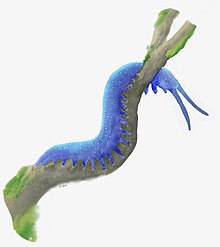Cretoperipatus
| Cretoperipatus Temporal range: Cenomanian
| |
|---|---|

| |
| Scientific classification | |
| Domain: | Eukaryota |
| Kingdom: | Animalia |
| Phylum: | Onychophora |
| Family: | Peripatidae |
| Genus: | †Cretoperipatus Engel & Grimaldi, 2002 |
| Species: | †C. burmiticus
|
| Binomial name | |
| †Cretoperipatus burmiticus | |
Cretoperipatus burmiticus is an extinct species of velvet worm that is known from Cretaceous Burmese amber approximately 100 million years old. It was found in Kachin state, Myanmar.
The species can be assigned to one of the modern families, the Peripatidae.[1] While only five leg pairs can be discerned, the information gained from the fossil is enough to preclude assignment to any known modern genus.
Cretoperipatus burmiticus is important in closing a gap between the only other known fossil onychophores, Helenodora inopinata from the Carboniferous and Succinipatopsis balticus plus Tertiapatus dominicanus from the Eocene and Miocene, respectively.
It was hypothesised that onychophorans could have migrated from Gondwana to Southeast Asia via the northwards drift of India. Research published in 2016 concluded that the age of Burmese amber supports an earlier migration through Europe. The same study also came to the conclusion that Typhloperipatus williamsoni is the closest extant relative of Cretoperipatus.[2]
References
- ^ Grimaldi, David A.; Engel, Michael S.; Nascimbene, Paul C. (2002). "Fossiliferous Cretaceous Amber from Myanmar (Burma): Its Rediscovery, Biotic Diversity, and Paleontological Significance" (PDF). American Museum Novitates. 361: 1–71. doi:10.1206/0003-0082(2002)361<0001:FCAFMB>2.0.CO;2. hdl:2246/2914.
- ^ Oliveira, I. S.; Bai, M; Jahn, H; Gross, V; Martin, C; Hammel, J. U.; Zhang, W; Mayer, G (2016). "Earliest Onychophoran in Amber Reveals Gondwanan Migration Patterns". Current Biology. 26 (19): 2594–2601. doi:10.1016/j.cub.2016.07.023. PMID 27693140.
